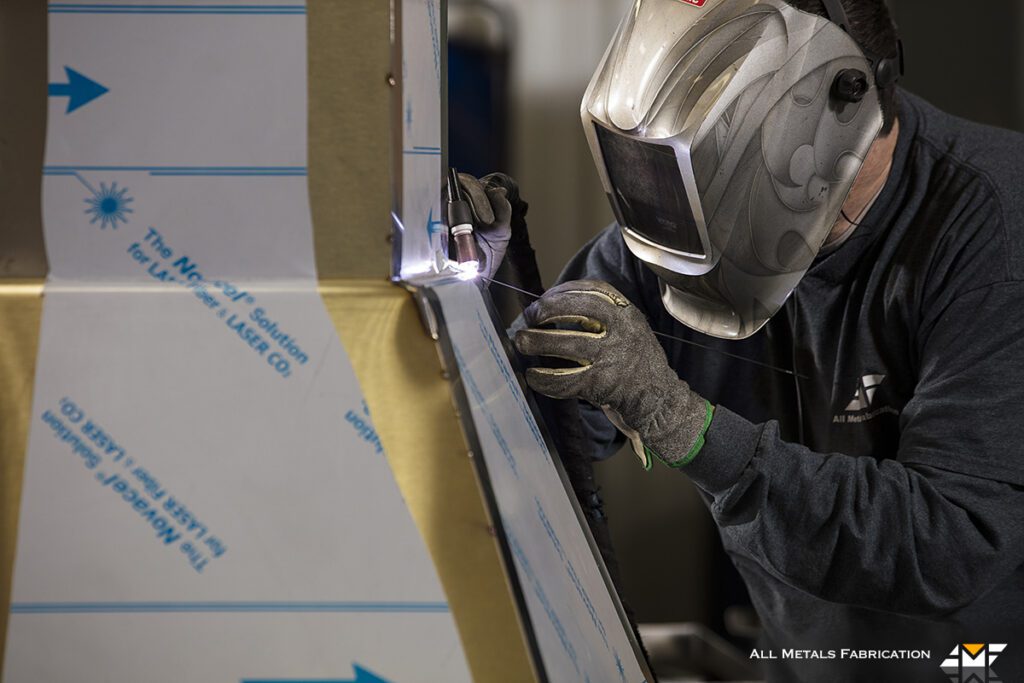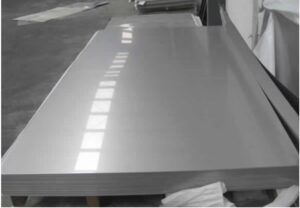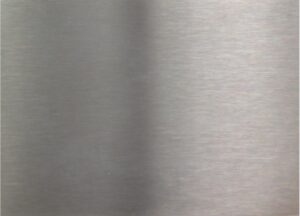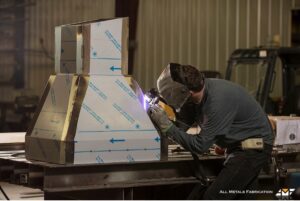
Stainless steel is a unique metal alloy usually composed of steel (iron/carbon) and chromium.
Stainless steel is widely known by most people as material that does not rust! It is sort of known as the superman of metal materials even though that title is not always deserved. Still, because stainless steel does get so much attention, it can be helpful, particularly in regard to fabrication, to talk about the variety of finishes available.
First, for clarification, stainless steel, purchased in thicknesses greater than .125″, usually only comes in hot roll form, meaning it will have no polish or finish. There are companies that specialize in graining and they can take the material sheets, usually sized around 48″ x 120″, and grind the mill scale off the material to accomplish a more visually attractive finish.
Stainless steel sheets purchased from .125″ down to .020″, can generally be ordered with either a 2B finish or a #4 finish. Any other variety of stainless steel finishes, like mentioned earlier, is usually accomplished with some type of post-specialty process like bead blasting, sanding, annealing, chemically treating or polishing.
People often ask what is the difference between 2B and #4 finish. We will address that question as follows, starting with 2B finish:

Stack Stainless Steel Sheets with 2B Finish
The most common stainless steel finish in the sheet metal fabrication industry is likely 2B. The 2B finish is done at the factory by using a cold rolled, heat-treated, pickled and pinch process. Most of us are not sure what all that means, but the result, visually, is a slightly reflective surface similar to a cloudy mirror.
The 2B finish does have a reflective look but not so reflective that you could see yourself like a mirror. The color and polish might remind some of the way a wet dolphin looks—grayish, somewhat shiny, but not shimmering, if that makes sense.
The 2B mill finish is the standard finish for grades that include 201, 301, 304, 304L and 316L stainless steel.
Stainless steel with a 2B finish is generally used for non-cosmetic parts. Items we typically see that employ a 2B finish include bakeware and flatware, fixtures, solar panels, industrial equipment, enclosures and covers.
Different from the gray, polished finish of 2B, #4 finish looks like something with a noticeable grain. Most people associate this with kitchen appliances. A close examination of your stainless steel fridge will show a very slight, #4 grain. The grain is subtle and can be disrupted by something as small as cleaning your fridge with a rough paper towel and rubbing the wrong direction.

Stainless Steel #4 Finish
#4 finish is sometimes called the workhorse finish because it looks attractive and because it is easy to maintain in high-traffic areas such as handrails, kitchen equipment, stainless steel sinks, bus shelters, elevator doors and work surfaces.
The #4 finish is manufactured by mechanically polishing the metal with fine abrasives belts to remove minimal amounts of metal from the surface. The resulting appearance has short, parallel lines for a linear effect. Stainless steel with a #4 finish will have a different appearance from manufacturer to manufacturer due to different belts and grit sizes, which usually range from 120 to 320 grit, and depending on the project requirements. The higher the grit, the finer the lines and the more reflective the surface will be.
Surprisingly, #4 finished stainless steel is more dull than stainless steel with a 2B finish. It appears more flat, less reflective, but even.
Because of the grained finish, light scratches can often be reclaimed by using a very light-grit finishing pad. Still, as sheet metal fabricators and craftsmen will tell you, this won’t be a project for the faint of heart. Once you start re-graining a surface, you will be forced to apply the graining to the entire surface to make it match. Graining one small scratch will, unquestionably, alter the appearance of the grain and you will be forced to apply the same work to the rest of the visible surface.
Sheet metal workers and metal fabricators often develop very specific skill sets when it comes to fabricating stainless steel—either in 2B finish or #4 finish. Individual craftmanship, even in today’s hi-tech fabrication industry, still plays a vital role when it comes to fabricating stainless steel parts and assemblies. Graining and welding, for example, are very technical skills that apprentice fabricators spend much time perfecting.
Since #4 finish stainless steel is designed for visual appeal, it generally comes supplied with a sticky, usually white-colored, PVC coating. This plastic, or PVC, can be peeled off the stainless steel.

All Metals Fabrication…TIG Welding #4 Stainless Steel
Fabrication professionals will usually leave the PVC on the stainless steel throughout the fabrication process, which will often include laser cutting, tapping, countersinking and forming.
That way, the material can be handled without worry of scratching, marring or marking the metal. When it comes to welding, fabrication experts will cut away the PVC, exposing just the edges that need welding, but will often, as mentioned before, leave the rest of the material protected until it reaches the customer.
Stainless steel is a very common material used in fabrication. There is so much more to discuss—topics such as contaminating stainless steel with carbon, passivating stainless steel, using different grades of stainless steel and galvanic reactants to stainless steel—these are all important elements that add to the stainless steel fabrication process.
All Metals Fabrication has been fabricating custom, job shop stainless steel over nearly three decades.
Learn more by emailing us at info@allmetalsfab.com.